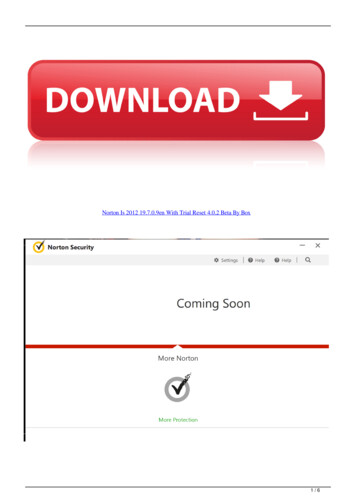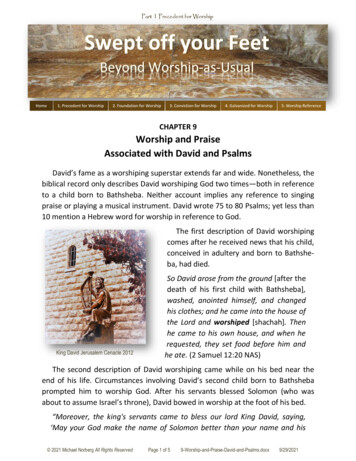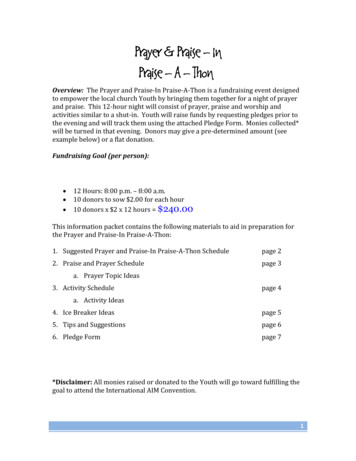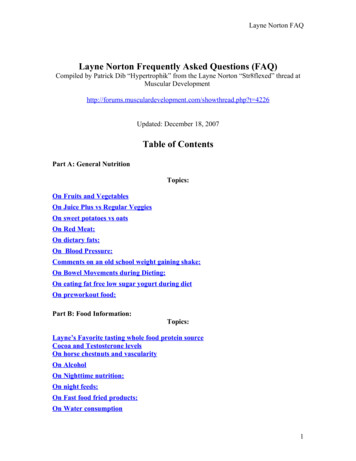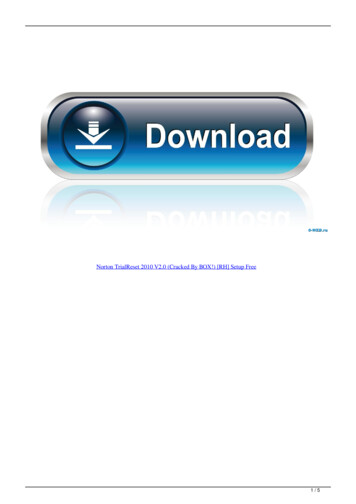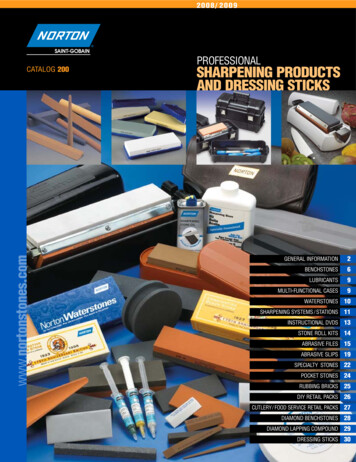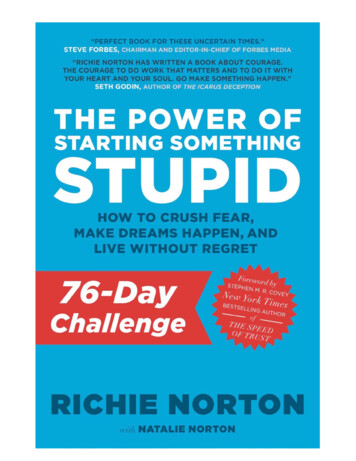
Transcription
Praise for Richie Norton &The Power of Starting Something Stupid“Thank you Richie Norton for inspiring us to authenticity and greatness.” — FORBES“This warm, wonderful book will inspire and motivate you to do more in your life than youever dreamed possible.” — Brian Tracy, author of The Power of Self-ConfidenceRichie Norton’s new book ThePower of Starting SomethingStupid is already getting mein a heap of trouble. As I wasreading it, I made notes toSteve (my husband). When Iwas done I handed it to himand said, “This could changethe way we live.”— Brené Brown,bestselling author ofDaring GreatlyI absolutely love this book.I love how it makes me feel.It energizes me, inspires me,and gives me confidence. Itreminds each of us that allthings are possible. . . .Thisbook disrupts conventionalthinking—in a smart way.— Stephen M. R. Covey,New York Times and the #1Wall Street Journal bestsellingauthor of The Speed of Trustand coauthor of the #1 Amazonbestseller Smart TrustToday I have over 120million YouTube views; it onlyseems like yesterday whenpeople thought that followingmy dreams could only be ahobby. Fortunately, as Richieteaches, ‘stupid’ was thesmartest thing I could do.— Devin Graham,content creator for theYouTube channeldevinsupertramp“When I wrote The E-Myth Revisited, I wasn’t an author and I really wasn’t interested in business, but Ihad discovered something about business that nobody else seemed to see, or understand, and I decided towrite a book about it. It came like a gift, a huge aha from out of nowhere, and I ran with it. Today, that‘stupid’ idea (everybody told me it wouldn’t work!) has created the most successful book on small businessever written because of that one, great stupid idea. I thought I was just lucky. Richie just told me that I’m inreally good company. Find out why stupid is now the New Smart. Read it, you’ll love it, you’ll find out whythinking stupid makes the best sense in the world.”— Michael Gerber,the world’s #1 small-business guru and author of the bestselling The E-Myth Revisited“Once in a great while a new author bursts on the scene to light a fire under us. Richie Norton is that rarespark. His certainty that the secret to success is to start something stupid is right on and will alter yourfuture. Thirty publishers thought Chicken Soup was stupid before it sold over 100 million copies. This newbook could not have come at a better time and Richie’s urgent and authentic style is readable, convincingand a compelling blueprint for success. Be smart: read The Power of Starting Something Stupid.”— Jack Canfield,New York Times bestselling author of The Success Principles, and cocreator of the Chicken Soup for the Soul series
TABLE OF CONTENTS:1.F irst things first2.a (very) brief introduction To the 76-day challenge3.the purpose of the 76-day challenge4.calendar5.phase ONE: GET CLEAR days 1-146.phase two: work smart days 15-457.phase three: finishing strong days 46-768.thank you9.special note10. contact
Hellofriend!Do you believe:1. that your life matters?2. that your life has purpose?3. that you are meant to be happy?Before you embark on the next 76 days, you must first internalize these three truths. Youmust embrace them completely—not just as general ideas that apply to the “collective we”or that exist for some kind of specific social categorization. You must believe that thesethree things are true of you, of your life.You start here, because in order to create the meaningful life satisfaction and successyou seek, you must first believe that you deserve this kind of life. You must believe thatyou deserve a life that consists of more than commuting, working, eating, surfing the Internet, sleeping and watching TV. There is an entire world full of excitement, energy, influence,purpose-driven projects and experiences, authentic meaning and joy—right at your fingertips. Reach out and take it!This 76-Day Challenge will help you start your very own “something stupid.” This plan willtake you by the hand and prompt your authentic self as you consciously make the kindsof choices that will give your life a sense of sincere purpose, leave you feeling vibrant andalive, and ensure that you live a courageous life, a life without regret.Go make some waves! Go start something stupid!Richie Norton, AuthorThe Power of Starting Something Stupidwww.RichieNorton.com/Blog
Firstthingsfirst.
Couple things you need to know:1.2.T his ebook is a companion action guide to my book The Power of StartingSomething Stupid. Throughout the 76-Day Challenge I make reference to pagenumbers in The Power of Starting Something Stupid so you can take a deep-diveapproach to making the principles I teach come alive. If you don’t have the bookyet, you can get it by clicking on this link: The Power of Starting SomethingStupid. That said, I’ve written this action guide in a way that you can still get incredible value and results by taking the steps without the book. My objectivewith this guide is not to sell you a book (besides, if you’re reading this you probably already have it). My objective is to help you live your best life. So read on and have fun!I recommend you print this action guide and take it one day at a time, checkingoff your progress as you go. Sure you could read this action guide real quick todayand assume you know it all and move on with your life — that method won’t makeany lasting change. Want to really start (and finish) something awesome? Really?Commit to actually taking action on the prompts I provide in the guide one.day.at.a.time. Try it out. If you really do the work, things will start to happen. Before releasing this action guide to the public, I first tested it with a select group ofpeople who told me that it helped their progress if I followed up by email. If youdownloaded this action guide from my website, I’ll send you follow up emails tohelp you along the way. If not, you can sign up here (you can opt out at anytime).Thanks!
A (VERY) BRIEFINTRODUCTIONTO THE 76-DAYCHALLENGE.
When our second son (Cardon) was born, he had a difficult time falling (and staying)asleep. After many long, sleepless nights, and many tears shed—both sweet Natalie’s (mywife) and Cardon’s own—we did what any good parent would do. We threw our handsup in the air and admitted that we had no business being parents. Clearly, we had exactlyzero idea what on earth we were doing.We consulted with our pediatrician. We devoted hours upon hours to personal study. Wetried every holistic (possibly read: voodoo?) trick in the books (and books and books).We devoured ever piece of information we could find in an attempt to solve our baby’ssleeping problem. Then, well then, we stopped everything and simply banged our headsagainst the wall (which ironically seemed to help the situation as much as any thing elsewe tried, go figure).Nothing worked. Nothing, that is, until one glorious day when we discovered the magicalkey that unlocked the golden gates of sleeping euphoria: FOCUSED SOUND.The hum of a fan, the whoosh of Natalie’s hairdryer, the sound of dense rainfall recorded to a compact disk (yes, this was long enough ago that we were actually still in possessionof a CD player) . . . the exact type of sound didn’t matter. Our infant son, with his newly developing brain, didn’t have the skills necessary to turn down the volume on all thesensory input around him. Thus Natalie and I, as his parents, stepped in and helped himsoothe and calm those distractions by introducing a clear sound for him to focus on.Once that focus was established, he was able to secure a healthy sleep pattern thatblessed all our lives.For the first time in nearly eight weeks (that’s approximately 64 days, but who’s counting?),our son (and his crazed parents) got more than two consecutive hours of sleep.Our once fussy, miserable baby had transformed, literally overnight, into the happiestbaby in town.
The purposeof the76-DAY CHALLENGE.
“The ability to simplify means to eliminate the unnecessary so that the necessary may speak.”– Hans HofmannLife, like infancy, can be exceptionally overwhelming. Many of you are, in this verymoment, overwhelmed beyond description. To you, I offer my most sincere empathy.Please, rest assured that you are most certainly not alone, and trust me when I tell youthat there is another way, a better way, to live.Overwhelm, anxiety, worry, fear, procrastination, confusion, lack of direction, lack of purpose and joy, the disparaging opinions of others . . . all of this discontent and more are symptoms of a very real and very powerful foe—an epidemic even—that is runningabsolutely rampant in today’s day and age. THE DISEASE OF DISTRACTION.At every turn, we are met with forces, powerful ones, which relentlessly (often, ferociously) vie for our undivided attention. Unfortunately, the vast majority of thesecompetitors for our time are mere distractions that cloud our thinking and prevent usfrom consciously and courageously engaging in the projects we are most passionateabout, and thereby, prevent us from living the life we are truly meant to live—the life ofour dreams.Friends, this is a frightening diagnosis, yes, but there is a way out.The trick is to turn down the volume on competing, unnecessary influences, so that youhave the capacity to hear and follow the most richly necessary (guiding) influences ofyour life. The 76-Day Challenge exists to help us do just that.Just as the simple presence of one, soft, consistent sound—a sound that was capable ofgently drowning out all the others—was enough to help our infant son focus his sensesand guide him into deep, restful sleep, there is purpose-filled, guiding direction availableto you. Over the next 76 days, as you work to consciously take your life by the reins, youwill uncover your very own clear and authentic sense of direction. This clarity and senseof direction will help you turn down the volume on the things in your life that matterleast, and help you turn up the volume on, and make room for, the things in your life thatmatter most.
Over the next 76 days: ou will exercise the courage to acknowledge your stupid ideas, despiteYdoubt, fear, or the opinions of others. You will dig deep and get in touch with a project or idea that authentically matters to you. You will accomplish at least one thing each day that is aligned with that overarching goal. You will acknowledge less than ideal life circumstances and commit to courageously stop letting them have control over the trajectory of your life. You will define and evaluate existing thought and behavior patterns and consciously recalibrate them as necessary in order to align them with youroverarching goals. You will face and overcome fears. You will face and overcome pride. You will face and overcome procrastination. You will develop a sense of your best possible self, become authentic, andembrace positive personal change. You will set and maintain standards for yourself: personally and within theframework of your project as a whole. You will embrace the principles of S.T.A.R.T (pgs. 115, 193-199, The Power ofStarting Something Stupid) and develop a plan of action to implement theminto your personal project and your life as a whole. You will work to identify and leverage existing resources by carefully, and authentically, engaging art of Mission Matching to accelerate success. You will occasionally reference the book, The Power of Starting SomethingStupid. (Remember, the 76-Day Challenge was created as a companion guideto The Power of Starting Something Stupid and is best understood by referencing the book as you move along.) You will face obstacles. Naturally, everyone’s experience will be different.However, no matter who you are or the goals you are working toward, theremay be will be difficulties and roadblocks along the way. Don’t become discouraged! Develop the mantra, “Learn and lean.” When challenges, mistakesand/or setbacks arise, learn from them (now: when the stakes are relativelylow). Then lean in to the journey, and keep moving forward. The lessons youlearn now will help you incrementally gain the skills necessary to face futurechallenges (later: when the stakes will likely be higher). You will face success! The 76-Day Challenge is driven by results. Take time toacknowledge, celebrate and be proud of even the smallest of wins and successes along the way! In short, you will get clear, get real, and get things done.
There is a wonderful world out there—a world of direction and purpose, a world of satisfaction and inspiration, a world of surety and peace. Yes! There is a wonderful worldout there, waiting . . . for YOU.WHY 76 DAYS?In my life, the number 76 is significant. 76 is the number of days our wonderful son, theinspiration for Gavin’s Law—Live to Start, Start to Live (pgs. 7-14, The Power of StartingSomething Stupid)—lived with our family here on earth. I often set project goals withinthis time frame, because it helps me to stay focused and committed, tethered if you will,to what matters most. It may sound silly, but this time frame makes me feel like I’mconsciously leaving a legacy for my son with every stupid project I complete.The practical reality is that 76 days is more than enough time to move any (yes, any)project from idea phase to measurable, and sustainable, action. Aside from the personalsignificance of the number, the reason this time bound action plan has proven to be sosuccessful for people is twofold:1. First, the 76-Day Challenge walks us through the process of breaking our bigpicture goals into smaller, more manageable and actionable projects (to becompleted over a consciously specified period of time). As we do so, we simultaneously transform the overwhelming psychology of an idea as a whole fromcomplex and impossible, to manageable and actionable. Suddenly the very ideasthat we didn’t think we could possibly begin at this point in our lives don’t seemnearly as daunting. This simple change in identification can very quickly transform an abstract thought into an actionable task or assignment.2. econd, research indicates that consistent, daily action toward specific ends inSmind, over an extended period of time, actually creates lasting change in thechemistry of the brain! Neural pathways that affect thought patterns and behavior are altered by consistent focus on and practice toward desired progress andchange. Thus, consistent, focused attention on intentional, positive and productive thought patterns and behaviors helps our brains replace old, potentiallydestructive, thought and behavioral patterns with healthy, new ways of thinkingand being.“The brain is built to change in response to experience. . . . brain circuits [are] malleable by theenvironment and are potential targets of training.”- Richard Davidson,one of the world’s leading researchers of brain developmentAs you focus and commit, you will use the next 76 days to successfully bridge the gapbetween where you are now, to where you truly want to be—building purposeful, productive and lasting momentum toward meaningful success.Be diligent. Be happy. Have fun.
76-DAY CHALLENGEDAYDAYDAYDAYDAYDAYDAYDAYDAY
PHASE ONE:GET CLEARDAYS 1-14.
Ready?Let’s do this thing!DAY 1—Prepare your physical environmentEveryone works well in a different type of physical environment. For me, I need a cleanspace, free from distraction. My wife, Natalie, likes to surround herself with books, imagesand quotes that inspire her. I like to listen to loud music—it sincerely helps me focus. Natalie requires absolute silence in order to get into “the zone” and get stuff done (so, yes,this can be a source of contention when we are both attempting to work from home, ha!).The point is, there’s no right or wrong process here, the goal is simply to create a spacethat works for YOU.TIPS:1. The space should be inspiring, but not distracting. Images that inspire you, quotes that fire you up—these are elements of inspiration. Piles of mail, mundane to do lists, television, cell phones etc—these areelements of distraction. Remember, we are trying to create a space where wecan turn down the volume on all outside distraction so that we can dedicate ourfiercest focus to specific “Dream Work.”2. The space should be different from where you normally work.If at all possible, try to select a space that is different from where you do otherwork. For example, if you generally sit down at your desk to pay bills and this isa stressful task for you, this isn’t the ideal environment for you to work on TheChallenge. Let me offer a personal example to illustrate. A few years ago, a close businesspartner and friend took advantage of me. He had essentially left our companywith a tremendous debt for which he should have been personally liable, however he was unwilling to take any kind of responsibility for his damaging actions.This was a trying time in my life, to say the very least. As I went through thedays and weeks of cleaning up this financial mess, my mind was nearly overcome with feelings of betrayal, anger, fear, injustice and intense, nearly debilitating stress. I spent hours and hours on the phone and in front of my computerworking to clean up this horrendous mess. In the end, everything worked out,and I was able to get things back on track. I have forgiven my old partner andcompletely moved on from this experience. Even so, I still cannot even thinkabout the physical work environment where I spent those stressful days andweeks without conjuring feelings of anxiety and stress. Again, it is important that you work from a space that is fresh, clear and new—free from any kind of past stress, pressure, anxiety, sorrow and so on.
3.S tock up.You need to be prepared in advance with anything you may need to make thevery best, and most effortless, use of your work time. Remember, the overarching goal here is to rid yourself of as many distractions as possible. Imagine for a moment that you have to get up and find a pen that works in themiddle of a focus session. Chances are, you’ll look for the pen in the same drawer where you’ll also happen across a picture of your old college roommate. Thiswill make you wonder what the heck they’re up to now, so clearly you’ll have totake a fast peek at Facebook (2 seconds, promise). On this long lost roommate’swall, you’ll find a link to a video of Kid President saying something totally hilarious and simultaneously profound (worthwhile right? All in the name of fuelingcreative energy). Suddenly you re-emerge from the abyss of the World WideWeb, and 3 hours have passed. You still don’t have a pen that works, and forsome reason you can’t explain, you find yourself watching a YouTube video of acat that has learned how to flush the toilet. Eliminate potential distractions by preparing your workspace with a journal ornotebook, pens, and anything else that you need to keep you focused.4. Get a timer.Keeping a timer at your workspace will help you stay on track. There will betimes when you need to sit down and work, when you really don’t feel like it.Setting a timer for a specified amount of time, will ensure that you stick with it—even when everything inside of you is screaming, “save it for later!” Set a timer, strap yourself in, and do.the.work. Getting started is often 90% ofthe battle. I highly recommend buying a simple egg timer etc rather than usingyour phone. . . this leads me directly into the final workspace tip. . .5. Disconnect.I highly recommend a workspace that is free of Internet access. There will always be a million reasons to quickly jump online. Resist the temptation by eliminating access. Thisgoes for cell phones too. Turn them off during focus time, or better yet, leavethem in another room all together.Don’t underestimate the importance of creating an intentional workspace. There is a reason this step comes before any of the “real work” can begin. The environment you createfor yourself will serve as a solid foundation for the work that is to come.
Days 2-10—PREPARE YOUR EMOTIONAL ENVIRONMENT.Imagine for a moment a photographer’s relationship with their camera. If said photographer had a big event coming up, they’d certainly spend some time inspectingand preparing their gear. They’d likely clean image sensors, update software, organizeequipment etc to ensure that they were prepared for peak performance on the night ofthe big event.For the kind of work you’re preparing to engage in over the weeks ahead, YOU are yourgear. YOU are your equipment. YOUR personal preparation for what lay ahead matters asmuch as (if not more than) anything else.I cannot stress this enough: You are the greatest tool for success that you have at yourdisposal.Over the next week, it’s your mission to inspect and prepare your emotional gear. If you’re not sharp, clear minded and present, you won’t be able to work at your optimumcapacity, and thus you won’t realize your highest potential for forward momentum andsuccess.Here are some ideas to help you prepare your emotional environment. Over the next few days (Days 2-10), you’ll use the following list as a sort of menu to help you preparementally and emotionally for the work that lies ahead. You may go through the list chronologically, or you may select the activities that feel most meaningful and applicableto you as you go along. If you find a particular exercise works especially well for you,don’t be afraid to repeat it again. Each time, you’ll learn something new and find yourselfin a healthier, more centered, mental and emotional space. The activities for days 2-10 canbe done in any order you choose.NOTE: these activities are designed to take a total of approximately 20 minutes a day.However, you’ll find that the shift in thinking they evoke will remain with you throughoutthe day. The cumulative effect of this process, aka doing these writing exercises everyday, is quite remarkable as it relates to preparing your emotional environment and gettingyour “gear” ready to make big things happen in the weeks ahead.Day 2—Engage in something you love.Mental and emotional clarity often follow engaging in something you truly love, something that really fires you up. Nothing clears my head like being in the water—surfingor swimming. Hiking in the mountains or doing yoga both help Natalie get her head onstraight. For you, it may be spending an afternoon reading a favorite book, going for along run, attending a concert, having dinner with an inspiring friend or family member,beating the stuffing out of a punching bag, attending a church service etc. The activityitself isn’t important, except that it has to be something that infuses you with energy andhelps you gain a greater sense of clarity. The goal here is to help you find your sense ofmental and emotional equilibrium by doing something you truly love.
Day 3—Spend some time alone.Life is high pressure and fast pace. The level of mental input and processing is nearly incessant. If you’re in a state of absolute mental and emotional overwhelm, a smart wayto settle your mind down to a state of greater calm is to spend some time away. I’m nottalking a weekend away (though that would be great if you can swing it), even 10 minutes 2 times a day will make a significant difference over 3-4 consecutive days. Just find aquiet place, free of outside distraction, and focus on deep breaths. If your mind wanders,simply bring it right back to your breath. Acknowledge the distraction that momentarilytook you away from the breathing, don’t fight it, but then just gently bring your focusback to your breath. It may sound hippy, but Natalie and I swear by the long term benefits of meditation. Seriously, ten minutes, twice a day. Doctor’s orders.Day 4—Explore obstacles that may have held you back in the past.Chances are you’ve met with obstacles in the past. Many were likely out of your control,but for this exercise, those aren’t the challenges we’re focusing on. Take a solid 15-20 minutes (set your timer and don’t stop writing until the timer goes off) and free write onthe following topic: What obstacles have held me back from success in the past? Am Iwilling to take ownership of those failures? How will I choose to respond differently in thefuture to ensure that I don’t make the same mistakes moving forward?This isn’t an opportunity to dump all over yourself! If you move through this exercise correctly, it should be liberating and energizing. It is an opportunity to get real and say,“Hey, I’ve screwed up before. Who hasn’t? Let’s see what I have to do to make sure itdoesn’t happen again.”If this exercise scares you, know this, it scares me too. But we’ve got to have the courageto ask ourselves this question, “What do I want more, my dreams or my excuses?”Day 5—Name your fears.You’ve got to name your fears in order to tame them. What scares you? Make a list. Freewrite for at least 15-20 minutes (set your timer and don’t stop writing until the timer goesoff). You might be surprised at what comes out. This exercise is important, because as wesee what frightens us, not only do we see what’s holding us back, but also, and perhapsmore importantly, we discover the things that matter most to us in our lives. Our fearsshow us the things that, at the core of who we are, have the potential to be the greatestmotivating forces in our lives.For example, when Natalie first did this exercise, she realized how afraid she was of notbeing a good mother. Of everything she was afraid of, this was at the very top of her list.Defining and understanding this fear allowed her to explore it more deeply, and as shedid, she learned that in order for her to feel the very most successful and fulfilled, she hadto ensure that every goal she set, every decision she made was broad enough to includea concern for the wellbeing of our children. Understanding this fear has been liberatingfor Natalie. Now, rather than being subconsciously held back by a fear she didn’t even
know she had, she is able to actively combat the fear by always checking her goals andaspirations against her most important motivating force: her desire to be a great mom.Since making this realization and actively working to overcome it in a healthy way (a waythat’s completely aligned with the wellbeing of everyone involved) Natalie has been moresuccessful and more fulfilled in her business and life than ever before.Day 6—Gratitude list.Gratitude can be one of the most empowering traits there is. When we truly see all wehave to be thankful for, we find we are capable of much more than we had ever dreamed.Gratitude proceeds hope, hope leads to greater energy and passion, and greater energyand passion lead to greater fulfillment and success.The following exercise is especially important for people who have been frustrated by failure in the past, or who feel bound by circumstance which is outside their realm ofcontrol, or for people who perhaps find themselves experiencing feelings of self pity asthey reflect on the things they have wanted to accomplish but have not yet achieved. Thisexercise is also helpful for people who find themselves experiencing jealousy over thesuccess of others. Remember, the goal during this phase of The Challenge is mental clarity—we can’t truly get clear without letting go of all the negative emotions (orthought patterns) that hold us back.Simply make a list of things you are grateful for. Free write for at least 15-20 minutes (setyour timer and don’t stop writing until the timer goes off). For some people, it is extremelyhard to get started. For others, the list seems to grow longer by the second with no signsof ever slowing down. Either way, it’s ok. Part of the goal here is to remind ourselves toadjust our focus to all that we have rather than all that we lack.A friend of mine was once in a group discussion about gratitude. They performed anactivity where they made their way around the circle over and over again as each personin the circle stated something that they were grateful for. One woman was really struggling with the activity. She couldn’t think of a single thing she was thankful for. Her lifehad been a series of injustices and failures. She was angry, and the activity seemed todiscourage her greatly. After much persuasion from another member of the group, shefinally looked up and said, “I’m grateful for my left thumb.” Laughter broke out among thegroup as the woman’s eyes welled with joyful tears. “I really am grateful for my thumb!”From there the list continued on and on, this woman had no shortage of things for whichshe was grateful. Once you got her started, she couldn’t seem to stop. I wish I could havebeen there to experience that immense power of gratitude first hand. I’m told it was adeeply moving experience for everyone present.Day 7—Weaknesses list.First things first, I’m not one to dwell on weaknesses. Overall, I believe in identifying andthen playing to your strengths. However, it is important to identify areas where we maylack so that we can be aware moving forward and thus fortify ourselves effectively. Thisactivity shouldn’t be discouraging! We are all strong in some areas and less strong in
others. No one is good at everything. By identifying our weaknesses, we can fortify ourselves against them. We can do this by seeking out collaborative working relationshipswith people who compliment us well. For example, if I tend to have a high tolerance forrisk, identifying and understanding that potential weakness would encourage me to surround myself with partners or associates or mentors who I trust to give me effectivefeedback along the way, and so on and so forth.Also, when we acknowledge our weaknesses, we enter a new level of self-awareness. Notonly are we able to safeguard ourselves more effectively, through acknowledging the areas where we may be weak, but we are able to work mindfully to turn
— Brené Brown, bestselling author of Daring Greatly Today I have over 120 million YouTube views; it only seems like yesterday when people thought that following my dreams could only be a hobby. Fortunately, as Richie teaches, 'stupid' was the smartest thing I could do. — devin graham, content creator for the YouTube channel
